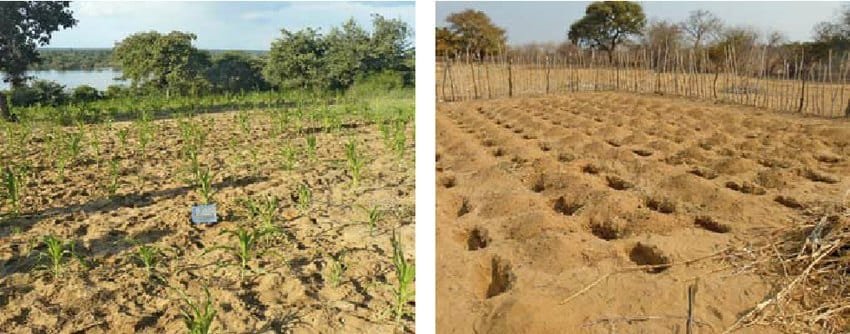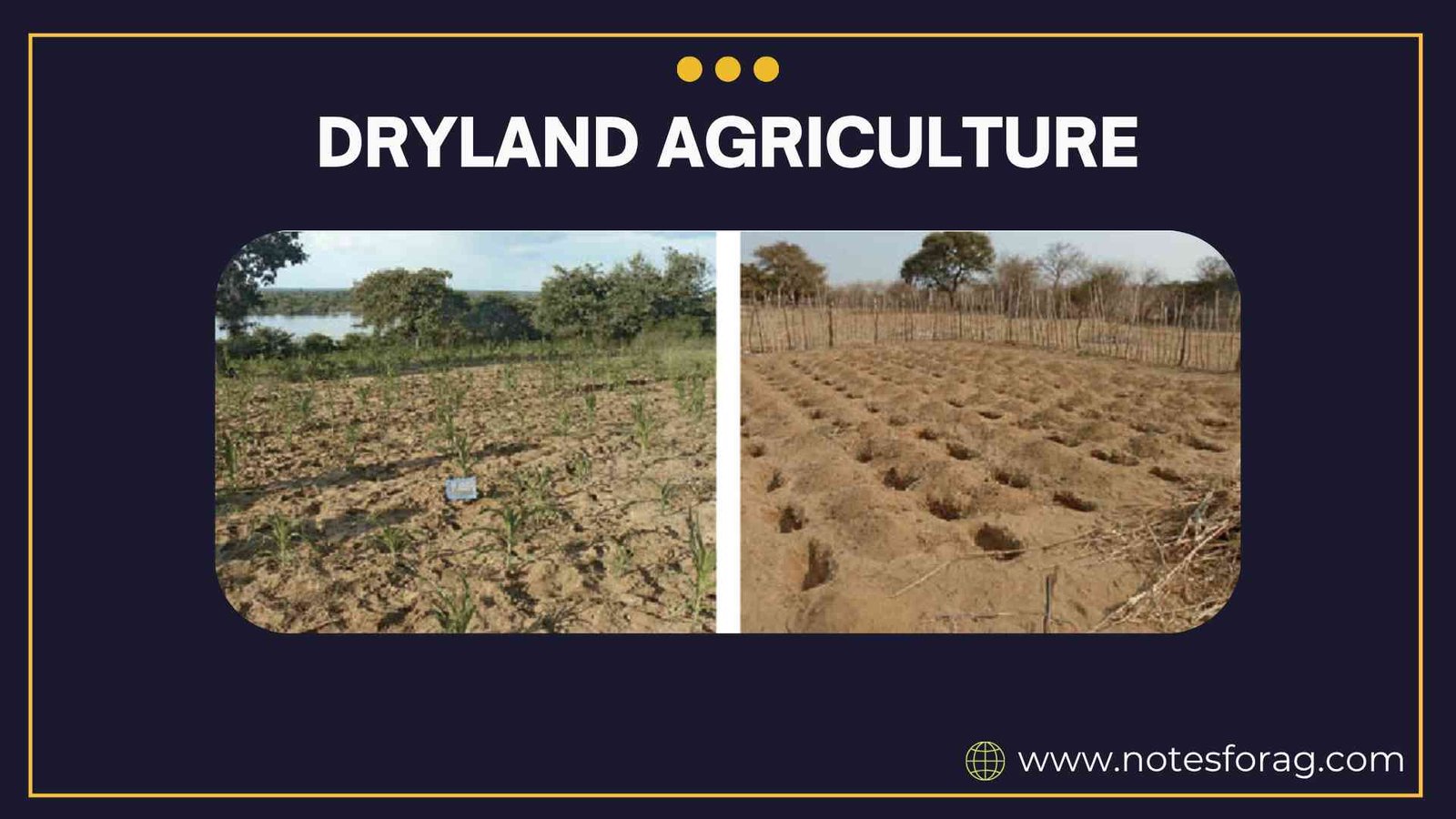INTRODUCTION

Dryland agriculture refers to the practice of farming in regions with low or irregular rainfall, where irrigation is not possible or is extremely limited. These areas generally receive less than 750 mm of annual rainfall and face frequent droughts, harsh climate, and poor soil fertility. This method of agriculture is vital for ensuring food security in arid and semi-arid regions, where traditional farming techniques may not be effective. Dryland farming involves using specialized techniques, selecting drought-resistant crops, and managing soil and water effectively to produce good yields under challenging conditions.
Summary of Dryland Agriculture
- Dryland agriculture is practiced in areas with low or erratic rainfall, relying solely on natural precipitation for crop growth.
- Techniques such as mulching, water harvesting, and soil conservation are employed to optimize water use and enhance soil fertility.
- Challenges include unpredictable rainfall, soil erosion, and limited access to resources, which can affect crop yields and farmer livelihoods.
Table of Contents
TYPES OF DRYLAND AGRICULTURE
1. Dry Farming
Dry farming is practiced in regions with less than 500 mm of rainfall annually. It is the most challenging form of dryland agriculture, as crops must grow using the limited moisture stored in the soil. Farmers choose short-duration crops and focus on soil conservation and moisture retention to succeed in such conditions.
2. Dryland Farming
This is done in areas that receive between 500 to 750 mm of rainfall annually. These regions face frequent dry spells and droughts. Farmers adopt practices such as water harvesting, intercropping, and using drought-tolerant crop varieties to ensure stable production.
3. Rainfed Farming
Rainfed farming occurs in regions receiving over 750 mm of annual rainfall, but where irrigation is still not available. While water stress is less severe here, farmers still use dryland techniques to manage rainfall efficiently and improve soil fertility for better yields.
CHARACTERISTICS OF DRYLAND AGRICULTURE
1. Rain Dependent
Dryland farming entirely relies on the rainfall received during the growing season. The success or failure of crops depends heavily on the timing, quantity, and distribution of rainfall.
2. Uncertain Yields
Due to unpredictable rainfall and frequent droughts, crop yields in dryland areas can vary significantly. Farmers must plan carefully and select suitable crops to reduce risks.
3. Drought-Resistant Crops
Only crops that can survive with minimal water are grown in dryland areas. Examples include millets, sorghum, pulses, oilseeds, and certain legumes that are adapted to dry conditions.
4. Low Soil Fertility
Dryland soils are often shallow, less fertile, and prone to erosion. Special soil management practices, including organic matter addition and mulching, are essential to maintain productivity.
5. Poor Infrastructure
Dryland areas often lack proper irrigation facilities, storage systems, transportation, and market access. These factors further limit the productivity and income of farmers.
CROPS GROWN IN DRYLAND AGRICULTURE
1. Millets
Millets like pearl millet (bajra), finger millet (ragi), and foxtail millet are hardy, drought-tolerant crops that thrive in dry regions and offer high nutritional value.
2. Pulses
Leguminous crops such as chickpea, pigeon pea (tur), mung bean, and lentils are common in dryland areas. They enrich the soil by fixing nitrogen and require less water.
3. Oilseeds
Groundnut, sunflower, and sesame are popular dryland oilseeds that can withstand dry weather and poor soil conditions.
4. Sorghum and Maize
These grains are resilient to drought and are widely grown in rainfed and dryland regions as staple food and fodder.
5. Cotton and Castor
These industrial crops are also suited to dry conditions and contribute to income generation in dryland zones.
TECHNIQUES USED IN DRYLAND AGRICULTURE
1. Mulching
Mulching involves covering the soil surface with organic residues or plastic sheets to reduce evaporation, conserve moisture, and control weeds. It improves water use efficiency.
2. Water Harvesting
Farmers construct small ponds, bunds, and check dams to capture and store rainwater. This water can be used during dry periods to support crops.
3. Contour Plowing
Plowing along the natural contours of the land helps reduce runoff and soil erosion, allowing more water to infiltrate into the soil.
4. Intercropping and Crop Rotation
Growing two or more crops together or in sequence helps in better resource utilization, soil fertility improvement, and risk reduction in case one crop fails.
5. Use of Drought-Resistant Varieties
Scientists develop special crop varieties that can tolerate water stress. Using such varieties improves yield stability under dry conditions.
6. Organic Matter Application
Adding compost, farmyard manure, or green manure enhances soil structure, water-holding capacity, and nutrient availability in dryland soils.
7. Reduced Tillage
Minimizing plowing and soil disturbance helps retain moisture in the soil and prevents erosion. It also supports beneficial microorganisms in the soil.
IMPORTANCE OF DRYLAND AGRICULTURE
1. Supports Rural Livelihoods
Millions of small and marginal farmers depend on dryland agriculture for food, fodder, and income. It plays a critical role in rural economies.
2. Food Security
Dryland areas contribute significantly to the production of cereals, pulses, and oilseeds, which are essential for national food supply and nutritional security.
3. Climate Resilience
Dryland farming systems are often more resilient to climate change. They use fewer external inputs, conserve resources, and help in adapting to changing weather patterns.
4. Promotes Sustainable Agriculture
Practices like water harvesting, organic farming, and soil conservation support sustainability and reduce environmental degradation in dry regions.
5. Utilizes Marginal Lands
Dryland agriculture makes productive use of lands that are unsuitable for irrigated farming, thus expanding the total cultivable area.
CHALLENGES IN DRYLAND AGRICULTURE
1. Erratic
Rainfall

The main challenge is the unpredictability of rainfall both in amount and timing. This makes crop planning and management difficult for farmers.
2. Soil Erosion and Degradation
Wind and water erosion deplete the topsoil, reducing fertility and damaging soil structure. Farmers must adopt soil conservation techniques to prevent land degradation.
3. Limited Access to Technology
Many dryland farmers lack access to modern tools, improved seeds, credit, and training. This limits their ability to improve productivity and income.
4. Market Constraints
Farmers often face poor market access, fluctuating prices, and a lack of storage facilities, leading to post-harvest losses and lower profits.
5. Pest and Disease Pressure
Crops in dry areas are vulnerable to pests and diseases, especially when stressed by drought. Integrated pest management practices are essential to reduce crop loss.
STRATEGIES TO IMPROVE DRYLAND AGRICULTURE
1. Government Support
Policies that promote insurance, subsidies for drought-tolerant seeds, and investments in water harvesting infrastructure can support dryland farmers.
2. Farmer Education and Training

Training programs on climate-smart farming, soil health, and efficient water use empower farmers to adopt better practices.
3. Research and Innovation
Developing new crop varieties, farming systems, and conservation techniques helps improve productivity and sustainability in dryland areas.
4. Cooperative Farming
Encouraging small farmers to form cooperatives allows them to pool resources, access inputs at lower costs, and collectively market their produce.
5. Digital Agriculture
Using mobile apps, satellite data, and weather forecasts helps farmers make informed decisions about planting, harvesting, and resource management.
CONCLUSION
Dryland agriculture is an essential part of global food production, especially in arid and semi-arid regions. Despite facing numerous challenges such as water scarcity, soil degradation, and unpredictable rainfall, it offers immense opportunities for sustainable farming, rural development, and climate adaptation. By adopting appropriate techniques such as water harvesting, mulching, intercropping, and using drought-resistant crops, farmers can increase productivity and resilience in dryland regions.
Investments in infrastructure, education, technology, and policy support are critical to strengthening dryland farming. It is also important to promote soil conservation, efficient water use, and market access to improve farmer income and food security. Empowering communities with knowledge and resources ensures that dryland agriculture not only survives but thrives in the face of environmental and economic challenges. With coordinated efforts, dryland farming can become a model of sustainability and resilience for future generations.
Frequently Asked Questions (FAQs)
What is dryland agriculture?
Dryland agriculture refers to farming methods used in regions where rainfall is low, irregular, or unpredictable, so farmers depend entirely on the natural rainfall without any irrigation to grow their crops.
What are the main techniques used in dryland farming?
To succeed in dryland farming, farmers apply techniques like mulching to reduce evaporation, harvesting rainwater to store moisture, conserving soil through contour plowing or terracing, and choosing drought-tolerant crops that can survive with minimal water.
What are the challenges faced in dryland agriculture?
The biggest challenges include erratic rainfall that makes crop growth uncertain, soil erosion caused by wind and water, limited availability of farming inputs and technologies, and the constant need to adopt sustainable practices to keep the land productive over time.
Related Articles

